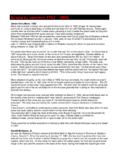Transcription of LESSON ONE The Articles of Confederation - Muse …
1 20 LESSON ONEThe Articles of ConfederationINTRODUCTION With the signing of the Declaration of Independence, the Continental Congress recognized the need to establish guidelines for a new government. Congress s overriding concern was to insure that the government was not a strong centralized body similar to British Parliament. With that in mind, the Articles of Confederation were drafted and adopted, providing the structure for governing the new nation. Unfortunately, the limitations of the Articles of Confederation became readily apparent soon after their implementation. OBJECTIVES As a result of this LESSON , students will be able to: 1.
2 Describe the historical events that led to drafting and adopting the Articles of Confederation . 2. Define and explain the meaning of the term Confederation . 3. List the provisions of the Articles of Confederation . 4. Analyze the Articles of Confederation and identify their strengths and OF LEARNING This LESSON meets the National Standards of Learning in the areas of chronological thinking, historical comprehension, historical analysis and interpretation, and historical issues Articles of Confederation Graphic Organizer Student-Friendly Version of the Articles of Confederation Articles of Confederation Graphic Organizer Teacher Answer KeySTRATEGy 1.
3 Remind students that in the 1770s the American colonies were attempting to break away from British rule. As a result, it was necessary for the new states to join together for their mutual survival and protection. 2. Review with students the events that led up to the drafting and adoption of the Articles of Confederation : A series of actions taken by Great Britain in its North American colonies lead to colonists resentment, including the Proclamation Line (1763), the Sugar Act (1764), the Stamp Act (1765), the Townshend Acts (1767), the Tea Act (1773), and the Intolerable Acts (1774).
4 Events in the North American colonies further aggravate tensions between Great Britain and American colonists, including the Non-Importation Agreement (October 1767), the Boston Massacre (March 1770), the Boston Tea Party (December 1773), the Battles of Concord and lexington (April 1775), and the Battle of Bunker Hill (June 1775).21 King George III declares the American colonies in rebellion (August 1775). The Second Continental Congress adopts the Declaration of Independence (July 4, 1776). Congress appoints a committee to draft the Articles of Confederation to create a new government for the united colonies (June 1776).
5 The Second Continental Congress approves the Articles of Confederation and sends them to the states for ratification (November 1777). The Articles of Confederation are ratified (March 1781). 3. Give each student a copy of the Articles of Confederation Graphic Organizer. Ask students what the word Confederation means to them. After a brief class discussion, share the formal definition: Confederation a group of states united under a weak central government. Write the definition on the board, and have students write it in the appropriate location on their graphic organizers.
6 4. Give each student a copy of the Student-Friendly Version of the Articles of Confederation . Introduce students to the document by reading and discussing, as a class, the preamble and first three Articles . Ensure that students understand the content and meaning of each article . Explain to students that the Articles of Confederation granted certain powers to the national government while giving others to the state governments. Divide students into small groups. Have half of the groups read all thirteen Articles to determine the powers the document granted to the national government.
7 Have the remainder of the groups read all thirteen Articles to determine the powers that were given to the state governments. 5. Reconvene the class and have students share their findings. Have students record the findings in the appropriate sections of their graphic organizers. Take some time to ensure that students have placed information in the correct portions of their graphic organizers. Finally, answer any questions students may have, and then review the concepts and powers described in the Articles of Confederation , ensuring that students understand the natural tensions created by attempts to balance state and federal powers.
8 [Note: For reference, see the Articles of Confederation Graphic Organizer Teacher Answer Key.] 6. Facilitate a class discussion in which students analyze their findings, focusing on the issues and concerns regarding governing the nation under the Articles of Confederation . Answering the following questions will help students understand how weaknesses in the Articles prevented the national government from operating effectively: Under the Articles of Confederation , how did the national government fund its programs? What did the monetary system look like? How were national laws enforced?
9 How were amendments to the Articles enacted? What was necessary to pass new laws? What was the role of the executive branch? After identifying and discussing these issues, have students record the answers in the appropriate bottom section of their graphic 7. With the class, summarize what students have learned about the Articles of Confederation . What were the Articles of Confederation ? When and why were the Articles written? What were the strengths and weaknesses of the Articles ? What were the challenges of governing the country under the Articles ?
10 LESSON ExTENSION Have each student write an acrostic poem using the letters in the word Confederation . Invite several students to share their completed poems with the from an engraving in the Massachusetts Centinel (Boston, MA), February 27, 1788. From the collections of the Colonial Williamsburg OF Confederation GRAPHIC ORGANIzERCONFEDERATION: _____ State Government Powers National Government PowersWeaknesses of the Articles of Confederation 24S T U D E N T- FR I E N DLy VE R S ION OF THE Articles OF CONFEDERATIONP reambleTo everyone who reads this document, we the undersigned delegates send of Confederation and permanent union among the states of New Hampshire, Massachusetts, Rhode Island, Connecticut, New York, New Jersey, Pennsylvania, Delaware, Maryland, Virginia, North Carolina, South Carolina, and I: The new nation will be called The United States of America.






